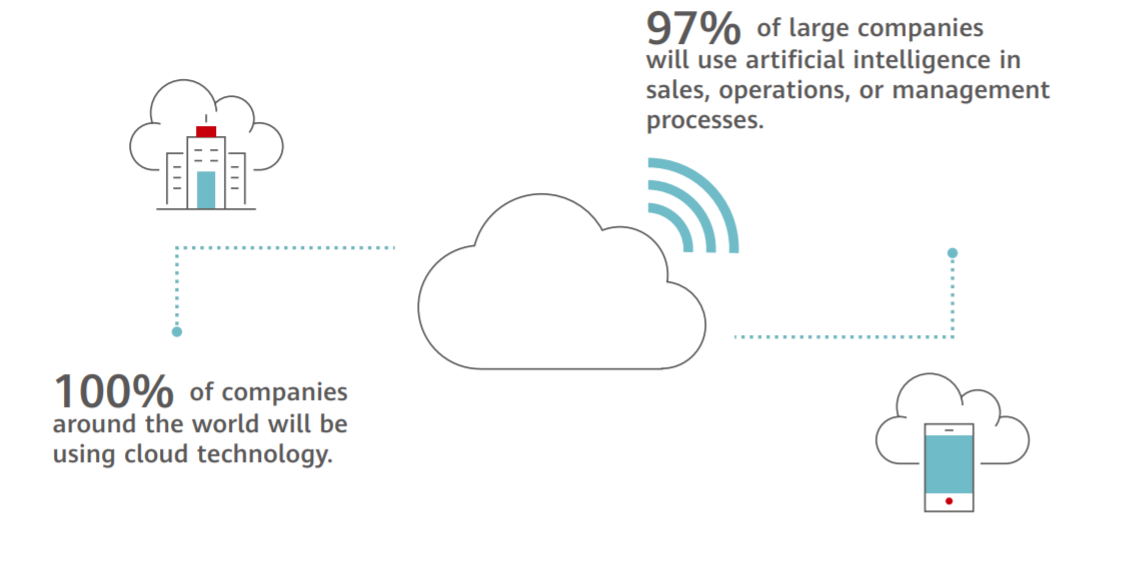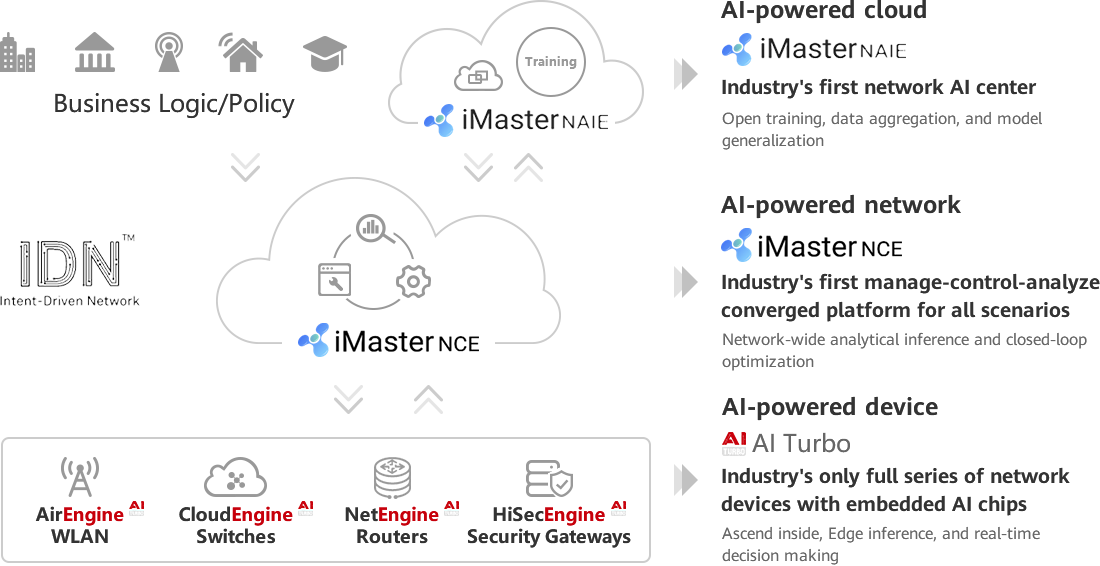This site uses cookies. By continuing to browse the site you are agreeing to our use of cookies. Read our privacy policy>
![]()
This site uses cookies. By continuing to browse the site you are agreeing to our use of cookies. Read our privacy policy>
![]()
Enterprise products, solutions & services
After more than 30 years of development, IP networks have laid a solid foundation for network connectivity that will empower an intelligent society. According to Huawei's forward-looking Global Industry Vision (GIV) 2025, 6.2 billion people will have access to the Internet and 100 billion connections will exist worldwide by 2025. In addition, enterprise digitization is accelerating. By 2025, 100% of all enterprises will use cloud services, and 85% of enterprise applications will be cloud-based. Enterprises of all sizes are already deepening their cloud and digital transformation initiatives. Against this backdrop, IP networks are required to carry more and more critical services, imposing ever higher requirements on IP networks.

For example, campus Wi-Fi networks are typically deployed in office buildings, large stadiums, and shopping malls. In these environments, the number of users in different areas fluctuates wildly, with demands for a variety of applications and services — such as email, web browsing, video conferencing, and e-commerce — all at the same time. Ensuring optimal service experience for such a high number and diversity of users poses significant challenges on the network. Traditionally, Operations and Maintenance (O&M) personnel have to manually adjust network resources, which is highly inefficient because the network cannot cope with the rapid movement of users — as a result, user experience cannot be assured. So, the question arises: can Wi-Fi networks become intelligent enough to proactively detect these constant fluctuations and automatically adjust resources accordingly to meet service requirements?
Artificial Intelligence (AI) may be the answer. AI-boosted campus networks could intelligently detect changes in the number of terminals and access locations, as well as requirement changes regarding bandwidth and service experience for Wi-Fi users. It could also predict trends and dynamically adjust Wi-Fi network resources to optimize network performance. Based on the above, Huawei collaborated with leading customers to jointly innovate Intelligent IP Networks. One such innovation is the AI-powered Wi-Fi solution which, according to Tolly's test results①, can improve the throughput of wireless air interfaces by 58% while reducing the Wi-Fi channel interference rate by 49%, compared with the industry average. Application of AI goes further, and can be used for intelligent O&M of campus networks where roughly 85% of faults can be rectified within 10 minutes.
Huawei believes that Intelligent IP Networks have the following characteristics:
Intelligent connectivity is the basis of the Intelligent IP Network architecture. Currently, many uncertainties exist on the IP network, such as insufficient negotiation — if it exists at all — for Service Level Agreement (SLA) between the service layer and network layer. As a result, the expectations (also called service intent) of the service layer are not clear at the network layer. This is the uncertainty on the demand side. In addition, the IP network is statistically multiplexed, meaning that resource usage level in the network layer constantly changes with the service and traffic — a symptom of uncertainty on the supply side. To eliminate uncertainties of these kinds, it is necessary to accurately sense the service intent first. For the demand side, the service layer could notify the network layer of service requirements, or the network layer could analyze service traffic characteristics (service models), proactively learn about terminals, users, and service types, and ultimately infer the expectations of the service layer. For the supply side, a unified platform for network management, analysis, and control can use AI algorithms such as neural networks to establish network models, detect and analyze network status in real time, and learn about network resource usage. Intelligent connectivity is also a process of matching service intent with network resources in order to continuously provide the desired connectivity services at minimum cost, hence achieving the goal of "application-driven experience".
Intelligent O&M is crucial to improving user experience. The current complaint-driven model for troubleshooting has brought significant challenges to network O&M. Since the network O&M department is often the last to know that a problem has occurred on the network, user experience cannot be ensured. The solution is proactive O&M, which ensures a better user experience. First, network status should be monitored in real time to check whether an issue or potential risk exists on the network. If an issue or risk is discovered, the root cause can be accurately identified by matching the fault patterns using AI technology, and faults are automatically fixed in a timely manner. In this way, problems can be resolved before user experience or services are affected.
Intelligent learning is the assurance of intelligent connectivity and intelligent O&M. The establishment of service models, network models, and fault models depends on AI training and the resulting analytic capabilities of intelligent learning. Thus, proper models can be established through AI training. In addition, through continuous evolution, AI training can increase the intelligence level of the entire system, allowing the system to adapt to rapid changes in services and networks and ultimately provide better services and experiences for users.
At HUAWEI CONNECT 2019, Huawei launched AI-boosted Intelligent IP Networks to advance Autonomous Driving Networks (ADNs) in the data communication field. This future-proof architecture features intelligent connectivity, intelligent O&M, and intelligent learning, with AI enhancements at three layers:
AI-boosted products: Huawei provides a comprehensive range of AI Turbo series products, which include NetEngine routers, CloudEngine switches, AirEngine WLAN products, and HiSecEngine security gateway products. These offerings deliver edge inference and real-time decision-making, and adjust IP packet forwarding policies based on service intent to ensure optimal service experience in real time.
AI-boosted network management: Huawei iMaster NCE can identify the intent of the service layer, automatically generate and deploy network configurations, and ensure that the network continuously meets the service intent. It can also detect the health status of the physical network in real time, identify anomalies, provide alerts, and offer handling suggestions in a timely manner. By using an expert system database, Huawei iMaster NCE helps to quickly troubleshoot network anomalies and optimize the network. Huawei iMaster NCE also delivers real-time visibility of SLAs, and enables predictive maintenance based on AI technologies. In addition, the system provides various visuals of the AI-powered network capabilities, enabling partners across various industries to customize their development.
AI-training service in the cloud: Huawei iMaster NAIE provides data lake services, model and training services, ecosystem openness, and developer services based on the cloud platform. These capabilities help enterprises gain AI algorithm expertise, grow AI developer teams, and build AI algorithm capabilities. Additionally, the training services help developers reduce the cost of computing resources. After data masking, data resources can be shared efficiently, helping developers effectively train models. Huawei iMaster NAIE also supports Federated Learning (FL) and transfer learning, overcoming model generalization problems and enabling model sharing.

Intelligent IP networks not only revolutionize campus networks, but also deliver breakthroughs in Data Center Network (DCN), Wide Area Network (WAN), and security firewall fields.
DCN + AI: The arrival of the AI era poses higher requirements on DCNs. According to related tests, a packet loss rate of 0.1% in a DCN can reduce the computing power of AI training by 50%. To combat this problem, Huawei launched the industry's first AI Fabric DCN solution, which achieves zero packet loss to fully unleash the AI computing power on a DCN. This solution uses AI technologies to implement predictive traffic scheduling, achieving zero packet loss on the network and improving data computing and storage efficiency by approximately 30%. In addition, Huawei and leading customers have made great progress in joint innovations by applying AI technologies to the intelligent O&M of DCNs. Huawei's solution can detect 75 types of frequent faults within one minute, locate them within three minutes, and rectify them within five minutes. Built on preceding Research and Development (R&D) and achievements from joint innovation, Huawei's AI-powered DCN solution can preliminarily implement the "intelligent understanding of service intent, intelligent selection of the optimal network path, intelligent evaluation of change risks, intelligent fault detection, as well as rapid location of fault root-cause". With these achievements, Huawei has taken the lead in creating a Level 3 autonomous driving network in the DCN field.
WAN + AI: In today's new era, "5G + Cloud + AI" is powering all industries. In particular, 5G provides unprecedented capabilities for wireless access, while cloud and AI offer almost unlimited scalability for intelligent computing (for a single tenant). Indeed, the bonding of 5G, cloud, and AI is delivered by DCN and WAN networks. The AI-powered DCN is the catalyst for adding “AI” onto the "Cloud", while the AI-powered WAN is the catalyst for combining "5G" and "Cloud". We hope to fully leverage AI technologies to advance the autonomous driving network in WAN networks. In doing so, we can unleash the full potential of 5G, cloud, and AI, enable millions of enterprises to migrate to the cloud, and supply all industries with the benefits of 5G. So, how can we make this a reality?

Similar to the DCN scenario, WAN networks can capitalize on AI to develop an autonomous driving network. Specifically, the AI-powered WAN can intelligently match network resources and select the optimal routes based on SLA requirements such as service latency. However, unlike the DCN scenario, WAN networks need to resolve one fundamental issue: how to quickly provision the WAN networks to meet different SLA requirements of various industries (for example, the end-to-end latency of 5G telemedicine must be less than 15 ms). In short, the new challenge for WAN networks is to help the physical forwarding plane "body" keep up with the AI-powered "management, control, and analysis brain".
Nowadays, an increasing number of enterprises are migrating to the cloud. Traditional WAN networks are no longer adequate as they need to be manually provisioned hop by hop, leading to poor deployment efficiency. At the same time, virtual machines and containers can be provisioned much faster, making WAN network deployment the bottleneck. A better alternative lies in Segment Routing IPv6 (SRv6), a next-generation routing protocol, which has multiple advantages. Its "source routing" mechanism has evolved from the traditional "node-by-node provisioning in multi-hop network" to "source node provisioning only". SRv6 greatly simplifies WAN deployment and enables the "body" to keep up with the "brain", realizing automatic and fast deployment in the WAN networks.
5G-powered industries have varied SLAs, especially in terms of latency requirements. To address this, the WAN uses the SRv6 protocol to program the network forwarding route based on the optimal path calculated by the management, control, and analysis system. In this way, a route with a deterministic route and latency can be quickly configured to meet the requirements of the service layer.
Therefore, SRv6 is a crucial forwarding plane capability of next-generation AI-powered WAN networks. SRv6 enables the WAN to "intelligently recommend the optimal route, quickly deploy optimal connections, and optimize the service SLAs in real time". Together with 5G and cloud technologies, SRv6 helps enterprises migrate to the cloud while powering all industries.

Network security firewall + AI: With so many variants, malwares are difficult to detect, as current firewalls struggle to deal with them through the conventional "signature matching" approach. Huawei demonstrated its leadership position by launching the industry's first T-level AI firewall, HiSecEngine USG12000 series. This cutting-edge product uses the unique threat detection AI Engine (AIE) to handle threats that cannot be detected by traditional firewalls — such as compromised hosts and communication with external Command and Control (C&C) servers — at network borders in real time, achieving an accuracy rate of over 99%. With embedded AI capabilities from the Ascend processor, HiSecEngine USG12000 improves the threat detection performance by five times. By leveraging intelligent security event analysis and intelligent security policy optimization technologies, HiSecEngine USG12000 achieves service rollouts in minutes and implements service-driven policy deployment and change, reducing Operating Expenses (OPEX) for security O&M by 80%. This next-generation AI firewall will provide intelligent network border protection and build impenetrable security for enterprises.
Customer-centricity is Huawei's core philosophy, with customer needs serving as the driving force behind Huawei's development. Through the NetCity joint innovation program, Huawei combines the requirements of leading customers with its own chip R&D capabilities to develop leading IP network solutions and shape the future of IP networks. Huawei will continue to work with customers and partners around the world to continuously innovate more cutting-edge products and solutions, and lead the way in intelligent IP network development.
①:https://reports.tolly.com/DocDetail.aspx?DocNumber=219142
《Huawei CloudCampus Solution AI-Powered Intelligent Radio Calibration on iMaster NCE (CampusInsight) Intelligent Radio Calibration Verification》